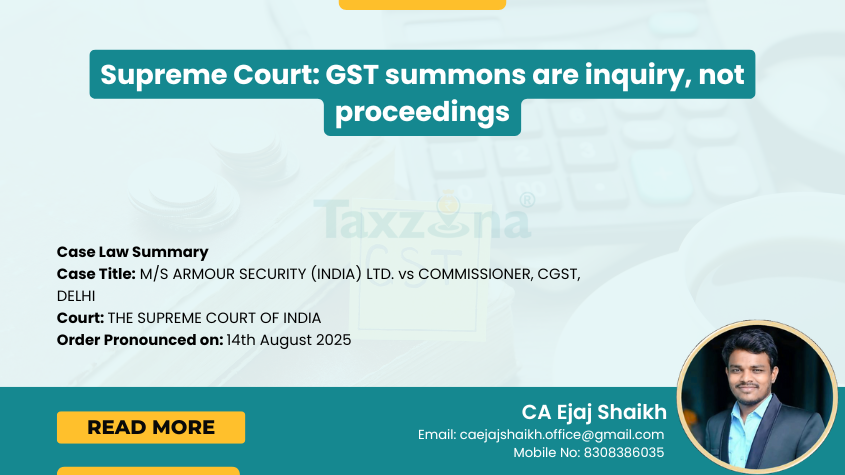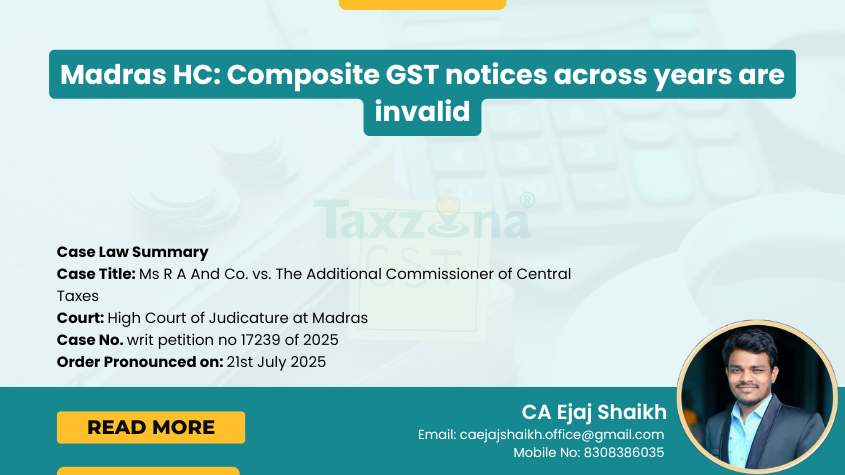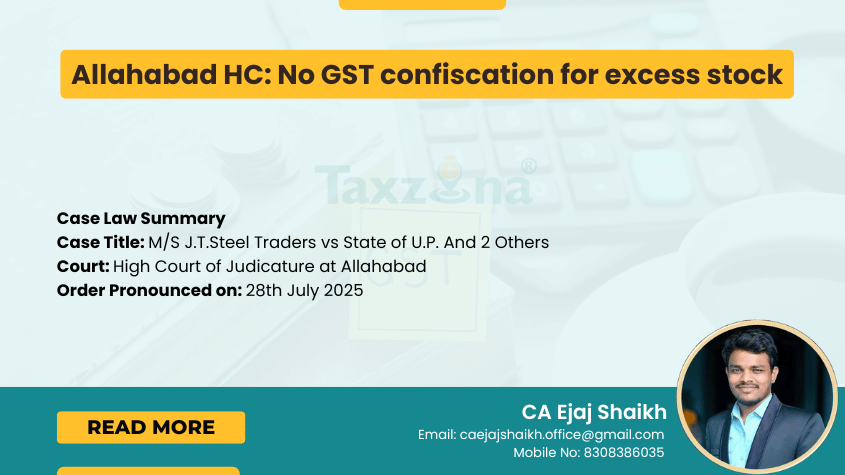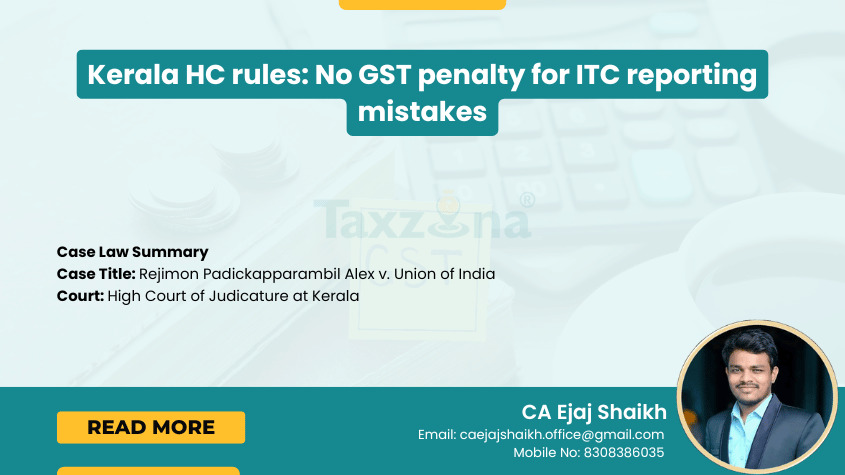
Madras HC Quashes Composite GST Show Cause Notices

1. Issue Involved
- The central issue before the Hon’ble Madras High Court was whether the issuance of a single show cause notice (SCN) and a composite assessment order covering multiple financial years (2017-18 to 2022-23) is permissible under Sections 73 and 74 of the CGST/TNGST Act.
- The petitioner contended that bunching of SCNs for more than one financial year is contrary to statutory provisions, the limitation framework, and constitutional guarantees, while the respondent argued that the Act does not expressly prohibit such practice.
Facts of the Case
1. The petitioner, Ms R.A. & Co., represented by its partner, challenged Order-in-Original No. 102/2025 dated 04.02.2025, passed by the Additional Commissioner of Central Taxes, which confirmed a tax demand of ₹ 30,13,02,903 with applicable interest and penalty. The impugned order was passed pursuant to a single SCN covering six financial years from 2017-18 to 2022-23.
2. The petitioner argued that:
- The GST Act mandates separate SCNs and assessment orders for each financial year since each year constitutes a distinct tax period under Sections 73 and 74.
- Issuance of a composite notice at the fag end of limitation for the earliest year prejudices the right to defend, as the assessee must respond for multiple years within a limited time.
- Such bunching creates hardships in availing compounding of offences under Section 138 or potential amnesty schemes, which may be applicable only to certain years.
- The practice violates Articles 14, 19(1)(g) and 265 of the Constitution and is contrary to the principle of separate limitation periods for each assessment year.
3. The respondent contended that:
- There is no express statutory prohibition against issuing a single SCN for multiple financial years.
- The phrase “any period” in Sections 73 and 74 empowers issuance of notices for a block of years, not just a single year.
- Since the Act also recognises monthly tax periods, clubbing yearly periods should be permissible to avoid multiplicity of notices.


3. Observations of the Court
The Court undertook a detailed analysis of Sections 73 and 74 of the GST Act and observed the following:
1. Statutory Scheme of Notices and Limitation:
- Sections 73(1) and 74(1) mandate issuance of an SCN when tax is unpaid or short-paid.
- Sections 73(3)/(4) and 74(3)/(4) permit subsequent statements for other tax periods, which are deemed notices, but only for periods within the same financial year.
- Sections 73(10) and 74(10) prescribe limitation of 3 years and 5 years respectively, reckoned from the due date of filing the annual return for each financial year. Thus, the limitation is year-specific and cannot be carried forward.
2. Meaning of “Tax Period” and “Any Period”:
- Tax period” under Section 2(106) means the period for which returns are furnished — monthly or annual.
- “Any period” in Sections 73/74 is construed in the context of “tax period,” hence restricted to a single financial year.
- GST law does not provide for multi-year returns, so SCNs cannot span multiple years.
3. Hardship from Bunching of SCNs:
- Composite SCNs deny assessees the ability to contest or settle specific years individually.
- Participation in amnesty schemes or compounding provisions for select years becomes impossible if notices are clubbed.
- The defence for each year may differ; bunching compels uniform treatment, which is unfair.
4. Precedent Analysis:
- Titan Company Ltd. vs. Joint Commissioner of GST & Central Excise (2024) 15 Centax 118 (Madras HC): Held that bunching of SCNs is impermissible.
- State of J&K v. Caltex (India) Ltd., AIR 1966 SC 1350 (SC): Each assessment year must be treated separately; limitation runs independently.
- Tharayil Medicals (Kerala HC): Reinforced that SCNs must be issued separately for each year to prevent misuse of the extended limitation under Section 74.
5. Constitutional Considerations:
- Composite notices violate Articles 14 and 265, as they impose tax without proper authority and fairness.
- The practice amounts to jurisdictional overreach by the department, rendering such orders void ab initio.
4. Judgment of the Court
- The Court held that bunching of SCNs and composite assessments for multiple financial years is impermissible under the GST Act.
- It ruled that each financial year is a separate unit for the issuance of notices, limitation computation, and adjudication.
- The impugned assessment order covering six years was quashed as being without jurisdiction.
5. Case Laws Relied Upon
- Titan Company Ltd. vs. Joint Commissioner of GST & Central Excise (2024) 15 Centax 118 (Madras HC) – Bunching of SCNs not permitted.
- State of Jammu & Kashmir and Others v. Caltex (India) Ltd. AIR 1966 SC 1350 – Each assessment year is distinct; it cannot be clubbed.
- Tharayil Medicals v. State of Kerala (Kerala HC, Division Bench) – Separate SCNs are mandatory for different years.
6. Key Learnings from the Judgment
- Each financial year is treated as a separate tax period under GST, and the limitation is calculated individually.
- Authorities cannot issue composite SCNs covering multiple financial years, even if issues are similar.
- Taxpayers gain procedural safeguards to contest or settle liability year-wise.
- This judgment strengthens the principle of fairness and legality in GST adjudication and prevents misuse of extended limitation provisions.
7. Conclusion
The Madras High Court’s decision unequivocally declares that bunching of SCNs and composite assessments for multiple years is impermissible in GST law. The ruling protects taxpayers from procedural hardship and reinforces that notices must be confined to individual tax periods (monthly or annual).
By quashing the composite order, the Court has re-emphasized the importance of year-wise adjudication, statutory limitation, and constitutional fairness in tax proceedings.
Recent Post



Have Any Question?
Our experts at Taxzona are here to help you with GST, Income Tax, and all your financial queries. Get reliable guidance tailored to your business and personal needs.

